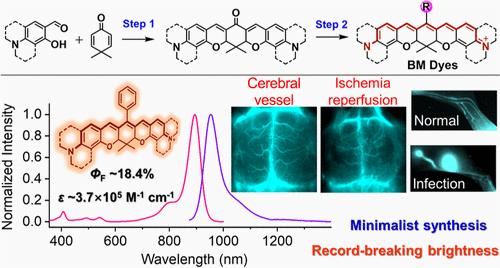用于NIR-II生物成像的明亮,稳健和易于获取的荧光团家族
IF 15.6
1区 化学
Q1 CHEMISTRY, MULTIDISCIPLINARY
引用次数: 0
摘要
高性能荧光团的缺乏仍然是快速发展的NIR-II成像领域的一个巨大瓶颈,因为现有的候选材料存在光吸收率低、发射效率差和合成繁琐的问题。在此,我们提出了一个简单的两步环化策略,以现成的材料构建一个创新的高亮度NIR-II染料家族,称为bm工程。BM染料具有完全刚性的共面骨架,具有优异的摩尔消光系数(εDCM = 1.9 ~ 3.7 × 105 M-1 cm-1)、荧光量子产率(ΦF = 10.4 ~ 18.0%)和光化学鲁棒性。值得注意的是,BM3以其卓越的NIR-II光学性能(ε = 3.7 × 105 M-1 cm-1, ΦF = 18.4%)重新定义了光学领域,巩固了其作为迄今为止报道的最亮的NIR-II荧光团的地位。利用这一优势,BM3可以在超低剂量下实现高分辨率生物成像,不仅可以照亮脑血管(3nmol)和淋巴血管(75pmol),还可以在缺血再灌注模型中准确检测细微的脑毛细血管损伤。更引人注目的是,BM3首次提供了由化学和细菌刺激触发的炎症淋巴系统的精确实时跟踪,揭示了以前难以捉摸的独特病理生理模式。除了实验验证之外,计算分析进一步揭示了分子结构与光学性能之间的复杂关系,为下一代NIR-II荧光团的合理设计提供了新的见解。这项研究不仅开创了超亮NIR-II荧光团的简化合成策略,而且扩展了生物成像精度和疾病诊断的前沿,为生物医学创新和临床应用释放了巨大的潜力。本文章由计算机程序翻译,如有差异,请以英文原文为准。

Bright, Robust and Readily Accessible Fluorophore Family for NIR-II Bioimaging
The scarcity of high-performance fluorophores remains a formidable bottleneck in the rapidly advancing field of NIR-II imaging, as existing candidates suffer from low light absorptivity, poor emission efficiency, and cumbersome synthesis. Herein, we propose a straightforward 2-step cyclization strategy to construct an innovative highly bright NIR-II dye family designated as BM-engineering from readily available materials. BM dyes featured a fully rigid and coplanar skeleton, exhibiting superior molar extinction coefficient (εDCM = 1.9–3.7 × 105 M–1 cm–1), high fluorescence quantum yields (ΦF = 10.4–18.0% in DCM), and remarkable photochemical robustness. Notably, BM3 redefines the optical landscape with its exceptional NIR-II optical performance (ε = 3.7 × 105 M–1 cm–1, ΦF = 18.4%), solidifying its status as the brightest NIR-II fluorophore reported to date. Leveraging this advantage, BM3 achieves high-resolution bioimaging at ultralow doses, not only illuminating cerebral vasculature (3 nmol) and lymphatic vessels (75 pmol), but also accurately detecting subtle cerebral capillary damage in ischemia-reperfusion models. More strikingly, BM3 provides the first precise real-time tracking of inflamed lymphatic system triggered by both chemical and bacterial stimuli, unveiling distinct pathophysiological patterns that were previously elusive. Beyond experimental validation, computational analysis further deciphers the intricate relationship between molecular architecture and optical performance, offering new insight into the rational design of next-generation NIR-II fluorophores. This study not only pioneers a streamlined synthesis strategy toward ultrabright NIR-II fluorophores but also expands the frontiers of bioimaging precision and disease diagnostics, unlocking immense potential for biomedical innovations and clinical applications.
求助全文
通过发布文献求助,成功后即可免费获取论文全文。
去求助
来源期刊
CiteScore
24.40
自引率
6.00%
发文量
2398
审稿时长
1.6 months
期刊介绍:
The flagship journal of the American Chemical Society, known as the Journal of the American Chemical Society (JACS), has been a prestigious publication since its establishment in 1879. It holds a preeminent position in the field of chemistry and related interdisciplinary sciences. JACS is committed to disseminating cutting-edge research papers, covering a wide range of topics, and encompasses approximately 19,000 pages of Articles, Communications, and Perspectives annually. With a weekly publication frequency, JACS plays a vital role in advancing the field of chemistry by providing essential research.

 求助内容:
求助内容: 应助结果提醒方式:
应助结果提醒方式:


